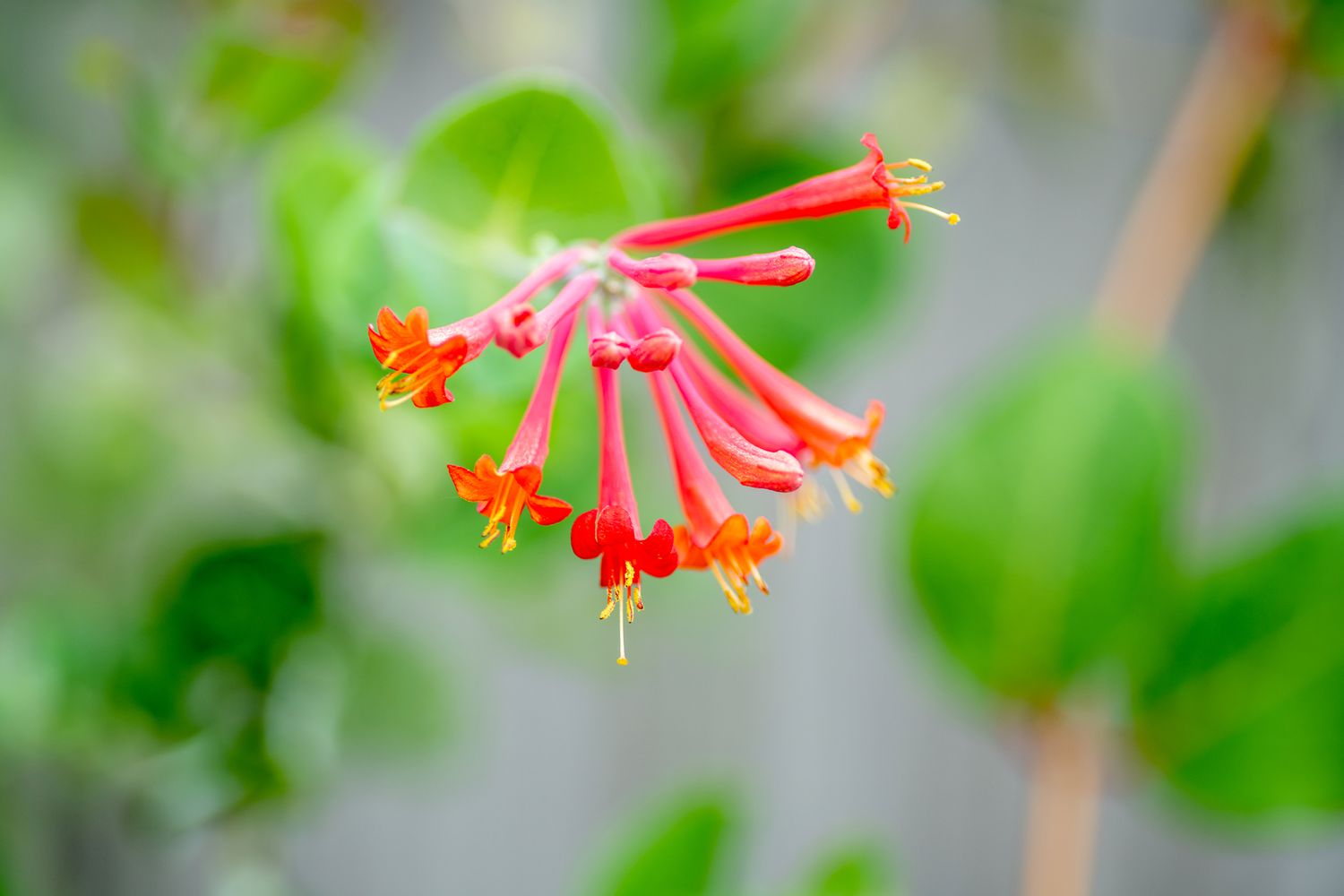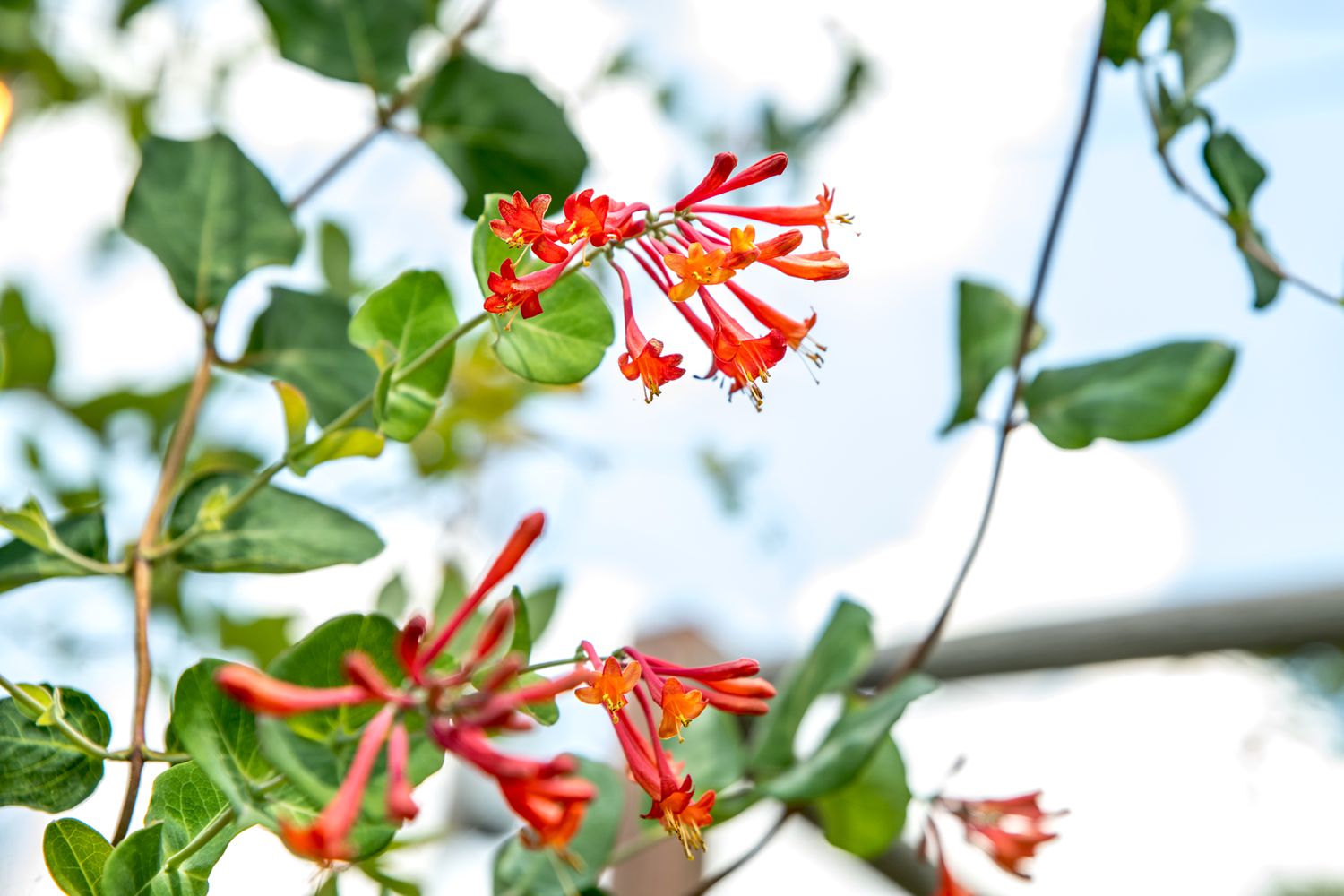During Southern summers, the sweet scent of honeysuckle (Lonicera periclymenum) is everywhere. Their green vines snake up trellises, adorn arbors, and break into bloom when the warm weather arrives, giving off clouds of honeyed fragrance that we always associate with summer in the South. Honeysuckle vines come in a wide variety—some are highly invasive, and others are non-invasive and good choices to plant in the garden. You’ll find honeysuckle in the wild, climbing trees and snaking through shrubs or up surfaces and structures, and its fragrance will alert you to its scent long before you see it. Sometimes honeysuckle is used as ground cover.
Honeysuckle has long, tubular blooms that give off a sweet scent and come in shades of yellow, white, orange, and pink. They’re a perfect planting if you’d like to attract hummingbirds, bees, and butterflies, as the tiny blooms are filled with nectar and draw garden visitors from near and far. In addition to the flowers, the vines also have dark green leaves. Train honeysuckle shrubs into hedge shapes, or use them in container plantings. Pruning helps ensure it blooms continuously throughout the season.
Plant Attributes
| Plant Attributes | |
|---|---|
| Common Name: | Common Honeysuckle, European Honeysuckle, Woodbine |
| Botanical Name: | Lonicera periclymenum |
| Family: | Caprifoliaceae |
| Plant Type: | Perennial, Shrub, Groundcover, Vine |
| Mature Size: | 12-20 ft. tall, 3-6 ft. wide |
| Sun Exposure: | Full |
| Soil Type: | Moist, Well-drained, Rich |
| Soil pH: | Neutral (5.5 to 8.0) |
| Bloom Time: | Spring, Summer |
| Flower Color: | Pink, Orange, Yellow, White |
| Hardiness Zones: | Zones 5-9 (USDA) |
| Native Area: | Europe, Asia, Africa |
Common Honeysuckle Care
Honeysuckle is a favorite plant because it’s heat tolerant and can thrive in the extreme weather of punishing Southern summers. It’s a hardy grower and can grow even under challenging conditions. It spreads quickly, sometimes grown as ground cover, and is available in climbing vines and shrubs. Staking can help the climbing varieties when establishing.
Moderate temperatures and sunlight exposure are best for these summer plants. Regularly watering and using well-draining, rich soil will help these plants thrive. If your region does not have fertile soil, amending the area with fertilizer might be necessary. Depending on the location, regular pruning will prevent this species from becoming invasive.

Light
Common honeysuckle is a heat-tolerant plant that requires at least six or more hours of daily sunlight. This plant will grow in partial shade but bloom less frequently. Plant honeysuckle in an area that resembles its native woodlands growing environment, protecting the roots in more shade and encouraging a climbing nature with stakes.
Soil
Common honeysuckle grows in most soil types but prefers organically rich, moist, and well-drained soil. Any fertile soil supports honeysuckle as long as it’s not soggy. The soil pH should be neutral as this plant will thrive in a slightly acidic or alkaline environment.
Water
If your region experiences prolonged droughts during the summer, remember to water honeysuckle, as newly established plants need consistent watering. After establishing, honeysuckle is relatively drought-tolerant but still needs moist soil—about one inch, or water from rain or manual watering every week. Mulching or adding organic compost can help honeysuckle retain its moisture. Since honeysuckle climbs, ensure the roots receive water around the base, especially structures that protect roots from rainfall exposure.
Temperature and Humidity
This heat-tolerant plant is relatively cold-resistant. Honeysuckle does not thrive in areas with too much humidity, as it needs adequate airflow to avoid fungal diseases from forming.
Fertilizer
Honeysuckle requires fertilizer if its planted area does not contain organically rich nutrients. To supplement honeysuckle, use a balanced fertilizer in the spring and thoroughly water the area. Honeysuckle benefits from one or two fertilizer supplements yearly, starting in February. To encourage more growth, add a nitrogen fertilizer, such as 2-10-10, but only if blooms are lacking because too much can stimulate too much foliage growth and become susceptible to pests.

Types of Honeysuckle
As with all fragrant vines, honeysuckle has a lot of popular varieties:
- Trumpet Honeysuckle (Lonicera sempervirens): One of the most common, this is also known as coral honeysuckle, which is a drought-tolerant, non-invasive honeysuckle that produces red and pink blooms and thrives in the South. It’s native to the eastern United States, and ruby-throated hummingbirds love it.
- Japanese Honeysuckle (Lonicera japonica): An extremely invasive honeysuckle with fragrant flowers, a vigorous climber often found twining up trees or shrubs.
- Winter Honeysuckle (Lonicera fragrantissima): An invasive shrub with white flowers that appear in the late winter and early spring.
Pruning
The common honeysuckle needs pruning, and training, to maintain its vigorous climbing nature. Once established, pruning honeysuckle is one way to keep the vine or shrub healthy by removing dead and damaged branches. Train the plant using stakes and ties to help it grow up a wall or trellis.
Prune vines throughout the year for their appearance, or cut the plant back to two feet above the ground in the fall or winter if growth becomes unruly. For shrubs, prune when the blooms are spent or drop in the spring. Remove damaged branches and cut them back to below the leaf node. Always prune after the last blooming period in the fall by cutting it around one-third, so you don’t remove new buds as it blooms on last year’s growth in the spring.
Propagating Common Honeysuckle
Propagate the common honeysuckle through semi-ripe cuttings, layering, or from seed. While all of these options will provide new honeysuckle plants, using cuttings is an easy way to multiply honeysuckle. Here’s how to propagate common honeysuckle using cuttings:
- Start by taking six-inch semi-ripe cuttings from the honeysuckle plant in the morning during the summer—July or August. The stems will be firm but flexible, and the cut should be at an angle.
- Remove the lower leaves.
- Place the cuttings in a well-draining container filled with potting soil. Keep the plant moist.
- Roots should emerge after a few weeks so you can transplant them to their new location.
How to Grow Common Honeysuckle From Seed
Growing honeysuckle from seeds is another way to propagate this plant. Save the seeds from the bright red berries that drop in the fall, or purchase some from a garden center. After collecting seeds, sow them directly in a container filled with potting soil or save them in a cold location to start them indoors, depending on the time of year. These seeds must be cold to germinate, so add them to a mixture of compost before placing them in the refrigerator. Keep seeds refrigerated for about 12 weeks and remove them in the spring to plant.
Overwintering
Winter care is relatively simple to maintain, depending on the type of honeysuckle planted and the region’s temperature conditions. Choose a hardier variety for the cold weather if you are concerned about the plant’s survival. Mulching helps protect the honeysuckle’s roots when the temperatures drop. In the fall, use three to four inches of straw or organic compost around the base of the plant. Add a burlap cloth covering to shelter the plant from frost. Remove coverings and mulch in the spring after the last frost passes. You don’t need to fertilize honeysuckle during the winter, as dormant plants can’t absorb nutrients.
Common Pests & Plant Diseases
Common honeysuckle is relatively susceptible to diseases and pests. Some fungi, like leaf blight, cause the foliage to curl or deform. Prune damaged or diseased foliage to stop the spread of disease. Powdery mildew and leaf spots occur in humid climates.
Some pests that infect the common honeysuckle include aphids, scale, and caterpillars, which insecticidal soap can control. Often only a gentle watering will remove pests from the plant.
How to Get Common Honeysuckle to Bloom
Provide at least six hours of daily sunlight to encourage blooming. Common honeysuckle planted in shady areas will bloom less often. The plant can take some time to establish, so the younger honeysuckle might not reach its full blooming potential for at least three years. While honeysuckle will bloom yearly, maintaining proper care will help your plant showcase better blooms and foliage.

Common Problems With Common Honeysuckle
Common honeysuckle is relatively disease and pest-resistant, but there are still some issues. Aphids are the most likely pest to infect honeysuckle, while other conditions may emerge because of improper care.
Curling Leaves
After an aphid infestation, honeysuckle is left with curling or distorted foliage as the pests» excretion causes mold. Aphids are more likely to attack plants in shady environments. Remove infested branches or leaves and apply insecticidal soap.
Leaves Turning Black/Brown
A plant pathogen called sudden oak death can spread to honeysuckle grown in gardens through the soil, though it is more common in wooded areas. If infected, the honeysuckle stems and foliage with turn brown or black around the edges. If detected early, removing damaged or diseased branches might save the plant. Leaf spots and too much fertilizer are also reasons why honeysuckle turns brown.